Part 7: Folk Dance Fundamentals and Terminology
25 Couple and Set Dance Figures
In this chapter, we look at a number of common figures done in couple, set and squaring dancing. There’s a lot in this chapter and it’s primarily meant as a reference guide rather than something to read through from beginning to end. While this chapter long, it’s also the case that it is most definitely not comprehensive. I could write a whole book just on the figures found in couple and set dances and not even scratch the surface. I’ve limited it here to the ones I think you are most likely to run into as a beginning or intermediate dancer. For more advanced figures I’ve listed a number of other resources at the end of this chapter.
As you work your way through some of the figures described here, you’ll want to have access to chapters 23 and 24, as I’ll be referring to various configurations and formations as well as different kinds of footwork that are described in those units. I’m going to start with figures that involve two people (or one couple), then look at figures that involve 4 people. Then I turn to some less common figures for 3, 6 and 8 people.
1. Figures Mainly Done by Two People
1.1. Figures You Do Essentially In Place or Almost in Place
Many set and couple dances start and end with the tradition of honoring your partner or honoring the other people you might dance with. These honors include bowing to the other person, curtsying, nodding your head, or much more rarely waving at them. (See chapter 26 on details of these moves). Honoring can also happen in the middle of the dance, particularly if there is a break in the music or a change of partners.
A much less common way of honoring another dancer is a choreographed embrace or hug. In many dance communities hugs are considered too intimate and might violate codes of conduct, so they should be used with caution.[1] There is a formalized and called tradition of hugging in square dancing: A hug with your corner is called a yellow rock and a hug with your partner is called a red rock. Dance teachers and callers should be cautious about using choreographed hugs without first checking with the community standards, where such an embrace might be considered too intimate or inappropriate. In such cases, a hug can easily be replaced with a bow, wave, salute or even a handshake.
A pattycake is a clapping and slapping sequence you do with another person, but you stand in place. Typically, these consist of a sequence (different for each dance) where you might clap your own hands, clap hands with your partner and slap your thighs or shoulders.
Setting refers to some action that is done with the feet that pretty much is done in place or very slightly side to side, while looking at another dancer who is doing the same action at the same time. The most common footwork for setting is a pas-de-basque, but you also find step-lifts or country-specific steps like the strathspey setting step in Scotland.
A balance is an action where you move towards and away from another dancer, typically while holding hands. If facing someone, you take one or both hands with them, step towards them and then immediately step away. Most often you balance forward on your right foot and back on your left. You can also balance with someone you are standing next to, whether they are facing the same direction or not. When you do this, you step to the side onto the foot closest to them, and then away on the other foot.
Technically this next figure isn’t one where you interact with another person, so it’s really a solo figure. However, it is typically done in couple and set dancing, so I’ll include it here. It is sometimes done in a flirtatious way where you look at your partner as you execute the solo move. This is the figure called turn single. In turn single, you don’t hold hands with anyone, you pull your right shoulder back and you make a complete clockwise rotation in place. The step can be executed with walking steps or with a pas-de-basque step. It can also be done by pulling the left shoulder back and rotating counterclockwise. A minor variation of this is to trace a clockwise or counterclockwise circle on the floor instead of rotating exactly in place.

Turn single should not be confused with turn alone, which is another figure done in place. In turn alone, you and your partner turn inwards towards each other and end facing the opposite direction from when you started. It differs from turn single in that in turn single you turn all the way around and end facing the original direction. With turn alone you only make a ½ turn and end facing the opposite way. When dancing side by side with a partner, the lark turns clockwise, and the robin turns counterclockwise. If dancing in single file or not next to someone, you pull your right shoulder back. In square dancing a turn alone is called a U-turn.

<insert video for figures done in place>
- Honor: An action, typically done at the beginning or end of a dance, where you acknowledge and thank a person you are dancing with. Honoring can be a bow, a curtsey, a wave, a handshake or even a hug.
- Hug: An embrace with both arms around the torso or shoulders of another dancer. Dispreferred/disallowed in many dance communities.
- Yellow rock: A hug with your corner.
- Red rock: A hug with your partner.
- Pattycake: A clapping and slapping sequence you do with another person, but you stand in place. Typically, these consist of a sequence (different for each dance) where you might clap your own hands, clap hands with your partner and slap you thighs or shoulders.
- Balance: An action where you move towards and away from another dancer, typically while holding hands. If facing someone, you take one or both hands with them, step towards them and then immediately step backwards. Most often you balance forward on your right foot and back on your left. You can also balance with someone you are standing next to, whether they are facing the same direction or not.
- Setting: Footwork done in place while looking at and acknowledging another dancer. Often done with a pas-de-basque step. But can also be done with step lifts or other specialized steps.
- Turn single: Pull your right shoulder back and make a complete clockwise rotation
- Trace a circle: A variant on turn single, where you trace a small clockwise circle on the floor instead of turning in place.
- Turn alone/U turn: Turn ½ way to face the opposite direction from where you started. If done next to someone, you and your partner turn inwards towards each other. If done solo, pull the R shoulder back and turn clockwise.
1.2. Moves Where You Go Forward and Back
Next, let’s consider figures where you, or you and your partner move forward and back. Let’s start with advance and retire or forward and back, here you face your partner (or another dancer), and you dance towards one another. This can be done solo (figure 25.3), holding hands with a partner (figure 25.4), or in lines of 3 or more (figure 25.5). When done in lines of 3 or more, it’s sometimes called “long lines forward and back”.


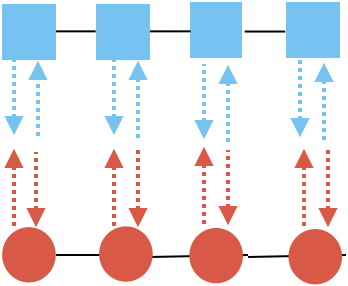
A version of advance and retire found in English country dance is called up a double. In this figure you do advance and retire, but everyone dances up towards the top of the hall, instead of meeting another person. Up a double can be done by just one couple, two couples or everyone in the set. The term ‘double’ in this figure isn’t really pertinent; it refers to the fact that you advance for 2 or 4 steps (rather than 1). It’s an old piece of dance terminology that’s rarely used anymore.

Another figure similar to solo advance and retire is siding. In siding, rather than advancing directly facing the person you are doing the figure with, you pass them on the side (usually passing R shoulders). You normally go up to their shoulder and then back up.
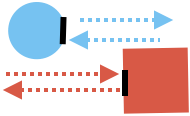
<Insert Video of forward and back moves >
- Advance and Retire/Forward and back: Here you face another dancer, and you dance towards one another. This can be done solo, holding hands with a neighbor, or in lines of 4 or more.
- Long lines forward and back: An advance and retire done in lines of 3 or more people,
- Up a double: Advance and retire, but everyone dances up towards the top of the hall (towards the music), instead of meeting another person. Up a double can be done by just one couple, two couples or everyone in the set.
- Siding: An advance and retire, where you go up to the side of the person you are advancing towards, rather than facing them head on.
1.3. Moves Where One Partner Turns
There are a number of partner moves where one person (typically the robin) turns under raised joined hands with their partner. The first of these is an inside turn, this is when the robin turns inwards towards their partner and ducks through under their raised joined hands making a complete counterclockwise turn without letting go of hands. This can be done when the couple is holding nearer hands (lark’s R, robin’s L) and it can be done when they are holding R hands with each other or L hands with each other. Typically, when holding nearer hands both dancers are facing the same direction and when holding either R or L hands they are facing each other – although this is not a firm and fast rule.


When the dancers turn the opposite direction, i.e. away from their partner to start and turn clockwise, the move is called an outside turn. Again, this can be done in a variety of handholds (figures 25.10 and 25.11).


There is an interesting terminological distinction that sits around outside turns. When the outside turn is part of the choreography (usually taking a set number of steps) we called it “outside turn”. But sometimes, especially in Contra and Square dancing, people will throw in an outside turn as a flourish at the end of a different move. In such cases, the turn is not choreographed, and it just steals counts from the other move. When this happens, we call the outside turn a twirl. People aren’t always consistent on this terminology, but the general understanding is that when the turn is choregraphed, it’s an outside turn, but when it’s improvised and tagged onto the end of a different move it’s a twirl.
Around the world turns involve one dancer rotating all the way around the other while not dropping hands. In figure 25.12, the lark dances in place, while the robin rotates all the way around him counterclockwise. They don’t drop hands so the lark’s right hand comes up and over their own head so that the robin can dance behind them. In an around the world turn, the robin might dance counterclockwise or clockwise.
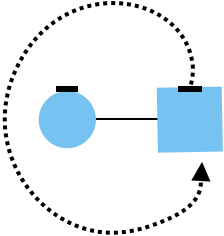
Finally, we have a kind of turn known as a roll-up. In this type of turn, you don’t turn under an arm. Instead, the arms are kept low, and the robin turns inward towards the lark. You end up in the sweetheart hold (see chapter 23)

<Insert Video of one partner turn figures>
- Inside turn: Retaining either nearer hands or both holding the R hand (much rarer the L), the robin executes a counterclockwise turn ducking under the joined hands.
- Outside turn: Retaining joined hands, robin executes a clockwise turn, pulling R shoulder back and then ducking under the joined hands.
- Twirl: This is a specialized version of an outside turn, which is done as a flourish at the end of another figure. It is typically not part of the choreography and “steals” beats from the figure it’s appended too.
- Around the world: One partner stays stationary, while the other runs all the way around them. They don’t drop hands, so the stationary partner has to raise their hand over their head to allow the moving dancer to get behind them and back to their original position.
- Roll up: Arms are kept low, and the robin turns inwards towards the lark wrapping the arms around her. The couple ends up in a sweetheart position.
1.4. Figures Where You and Your Partner Rotate Around Each Other
Next, we turn (no pun intended) to figures where two people rotate around each other, while not really progressing around the room more generally. The first of these is the one hand turn. In a right hand turn you give your partner your R hand and you rotate around them clockwise. In a left hand turn you give your partner your L hand and you rotate counterclockwise around them. The turn can be any degree around: You could turn ½ way, ¾ or all the way around.
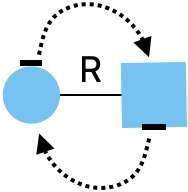
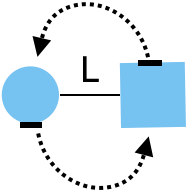
In contra dancing, right and left hand turns are sometimes called allemand R and allemand L, but this is confusing because the term “allemand” means different things in other styles of dance. In square dancing in an allemand L, you grab your partner’s (or corner’s) elbow with your hand so that your L forearms are touching. Then you rotate counterclockwise around each other, but you only go halfway, so you end facing the opposite direction from which you started. The R handed equivalent of a square dance allemand L isn’t called an allemand R, it’s called a turn through. To make things even more confusing the term “allemande” is used for a completely different figure in Scottish Country Dancing, where two couples exchange places (see the section on special figures for Scottish Country Dancing below for details).
A common variant on the R and L hand turns is the elbow turn. Elbow turns are just like R and L turns except you hook elbows with the other dancers rather than taking hands. You can also do clockwise or counterclockwise rotations while holding two hands with the other dancer. Unsurprisingly, this is called a two hand turn (figure 25.16).
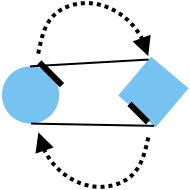
There is also a family of rotational moves called swings. Swings are different from turns in that they are typically done in a close hold such as ballroom position or similar hold and the speed of the turn is significantly faster than that of a hand turn. Swings are done with significant centrifugal force and usually the swing goes multiple times around and around. In most swing styles, the dancers stand right hip to right hip. They can be done with a walking step, or they can be done with a paddle/rida/buzz step. A wide variety of holds can be used, but they are always close, and they always allow for a significant giving of weight to create the force necessary to get the fast speed. Swings in Scottish country dances are called birls.
<insert video of various types of turns and swings>
- Right hand turn: Rotate clockwise around another dancer while holding R hands with them. The turn can be all the way around, or only ½ or ¾ of the way around. Also called an allemand R in contra dancing.
- Left hand turn: Rotate clockwise around another dancer while holding R hands with them. The turn can be all the way around, or only ½ or ¾ of the way around. Also called allemand L in contra dancing.
- Allemand R (contra): Rotate clockwise around another dancer while holding R hands with them. It is the same thing as a R-hand turn. Not the same as allemand R in square dancing.
- Allemand L (contra): Rotate counterclockwise around another dancer while holding L hands with them. It is the same thing as a L-hand turn. Not the same as allemand L in square dancing.
- Allemand L (square dance): Rotate ½ way around counterclockwise with another dancer to end facing the opposite direction from where you started. You hold the other dancer’s L elbow with your L hand so that you are forearm to forearm.
- Turn through (square dance): Rotate ½ way around clockwise with another dancer to end facing the opposite direction from where you started. You hold the other dancer’s R elbow with your R hand so that you are forearm to forearm. (This is the R handed equivalent of a square dance allemand L)
- Elbow Turn: Hook R or L elbow with partner, turn them around either clockwise or counterclockwise.
- Left Elbow Turn: Hook L elbows with another dancer. Rotate around them counterclockwise.
- Right Elbow Turn (called Arming in English Country dance): Hook R elbows with another dancer, rotate around them clockwise.
- Two hand turn: Do clockwise or counterclockwise rotations while holding two hands with the other dancer.
- Swing: A fast rotation around a partner, usually in some close hold (e.g. a ballroom or shoulder-waist hold, but other holds are possible). The dancers stand R hip to R hip and there are multiple rotations around. The footwork can be a rida/buzz step or simply a walk, but significant centrifugal force makes the turns fast.
Some rotational figures are done without holding hands. The simplest of these is the walk around. Historically, this move was called a “gypsy”, but this term is considered highly offensive by the Roma people, so we no longer use the “g-word” when describing this move. In a walk around, you do not hold hands with your partner, instead you lock eyes with your partner and don’t stop looking at them throughout the move. Then you rotate around each other until you get back to place. Typically, the rotation is clockwise. The key to a walk around is that you stay face to face with your partner the whole time.
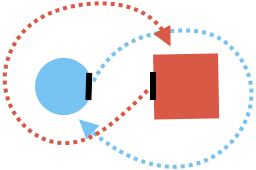
For many people who don’t folk dance regularly the only thing they remember about square dancing is the figure called dosido (or dosado). The term comes from the French dos à dos which means “back to back”, and in some traditions (e.g., country dancing), it’s actually called back-to-back. In a dosido, you stay facing the same direction the entire time you are rotating around your partner. You both dance forward and pass R shoulders. Then you shift to your own right, passing back to back with your partner, then you back up to your original position passing L shoulders with your partner as you do.
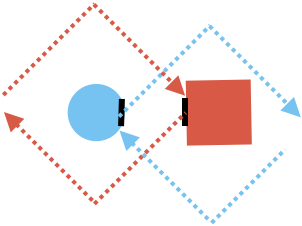
A flourish on the dosido that is often found in modern contra dancing involves spinning individually counterclockwise (pulling left shoulder back to start) as you trace the path of a dosido. This is sometimes called a fancy dosido. It’s also possible to do a dosido passing left shoulders first thus causing the main pathway to have a counterclockwise rotation. This L shoulder dosido is called a see saw (or sometimes see saw your ta).
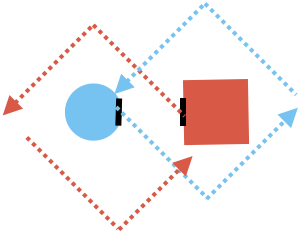
A mad robin is like a dosido but done with a person to your side instead of the person in front of you. It can be done clockwise or counterclockwise. With a counterclockwise mad robin, the person on the right passes in front of the person on the left. So, the person on the right steps 4 steps to the left; the person on the left moves to the right. They then pass shoulders, and then repeat back to place with the other person passing in front, moving to the L. The clockwise version is essentially the same, except the person on the left starts by passing in front of the person on the right, by moving to the right. When done in a traditional English or contra dance, you face your partner across from you and maintain eye contact with them while mad-robining with the person beside you.
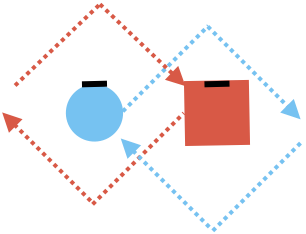
<insert video of dosido-like figures>
- Walk around: Lock eyes with partner and each makes a complete clockwise rotation around each other while looking at each other.
- Dosido/back-to-back/dosado: Pass partner by the right shoulder. Move to the right, passing partner back to back and then back up to place passing their left shoulder.
- Fancy dosido: This is a dosido, where each individual also spins individually counterclockwise while tracing the pathway of the dosido.
- See saw: A left shoulder counterclockwise dosido: Pass partner by the left shoulder. Move to the left, passing them back to back and then back up to place passing their right shoulder.
- Mad robin: This is a sidewards dosido performed with the person to your side rather than the person you are facing. It can be done with either a clockwise or counterclockwise rotation.
1.5. Moves to Exchange Places that Involve Movement in a Straight Line.
Next, we turn to various couple dance moves that involve switching positions with someone. Perhaps the simplest of these moves is the pass through. In this move you simply pass another person, typically passing right shoulders.
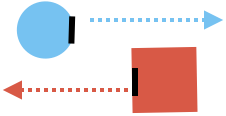
A variant on the pass through is the pull-by. It’s the same as the pass through, except you briefly grab right hands as you pass and you “pull” to get past the other person.
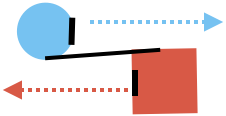
In both pass through and pull-by, after you’ve passed the other person, you stay facing the same direction you were before you began the maneuver. Often you do this so you can engage with a different person who is coming towards you from the next minor set above or below. But there is a variant of the pass through where you pull your right shoulder back and end facing the person you started the move with. This variant, which is common in English country dancing is called change places.

Another lateral swap is seen with the move known as slide across (or sometimes just slide). In this figure you exchange positions from side to side rather than forward and back. Starting facing in opposite directions and holding right hands, both dancers take a few steps to their own right, swapping to holding left hands as they exchange positions (figure 25.24). They end in swapped positions, holding left hands, facing the same direction as when they started (figure 25.25).

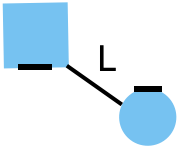
The next figure, the half sashay, is really similar as the slide across except both dancers are facing the same direction to start in the half sashay, whereas in the slide across they start facing different directions. In a half sashay, the lark slides to the right into the robin’s place, while the robin slides to the left in front of the lark.
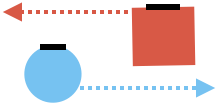
A much more common variant is known variously as a roll across, a roll-away, a roll or a roll-away with a half sashay. In this move, the lark steps to the right, just as in a half sashay, but the robin’s pathway is different. The couple start holding inside hands (lark’s right, robin’s left). As the robin passes in front of the lark, the robin turns counterclockwise to face the lark. The dancers switch hands, so that the robin’s right hand is now in the lark’s left as the robin rolls out on the lark’s left side.
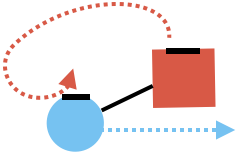
This can also be done with both partners rolling across. The robin rolls across counterclockwise as in the roll-away with a half sashay. But the lark also rolls, they roll clockwise. The person on the right (usually the robin) rolls counterclockwise in front and person on the left (usually the lark) rolls clockwise behind the robin. This is a double roll-away (figure 25.28).
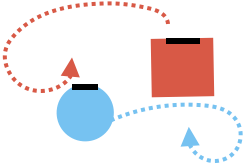
Finally, we have the square dance move known as run (not to be confused with the footwork called run). The run figure involves one of the dancers sliding to their right, while the other one dances forward in a loop around them into the now vacated position. In figure 25.29, the lark and the robin are facing in opposite directions, the lark is going to “run”, dancing forward in a loop around the robin’s position. The robin takes a step to the right to get out of the way. The figure ends with them both facing the same direction.

<Insert Video of partner exchanges that involve a lateral or forward and back motion:>
- Pass through: Simply pass another person, typically passing right shoulders, to greet a new person coming towards you.
- Pull by: This is similar to a pass through, except you briefly take right hands and pull past the other dancer as you move forward.
- Change places (English): Pass partner by the right shoulder into partner’s position, then pull right shoulder back turning to face partner again.
- Slide across: In the typical slide across you and your partner are facing in opposite directions and holding right hands with each other. You take a few steps to your own right, passing your partner face to face and exchanging hands ending up on your partner’s left.
- Half sashay: A half sashay is like a slide across, except both dancers start facing the same direction. The person on the right, slides to their left in front of their partner, while the person the left slides to their own right behind their partner. You stay facing the same direction through the entire move.
- Roll across/Roll-away: The lark steps to the right, just as in a half sashay, but the robin’s pathway is different. The couple start holding inside hands (lark’s right, robin’s left). As the robin passes in front of the lark, the robin turns counterclockwise to face the lark. The dancers switch hands, so that the robin’s right hand is now in the lark’s left hand as the robin rolls out on the lark’s left side.
- Double roll across: Similar to a roll across/roll away, except the person on the left also rolls. They roll behind the person who is rolling across in front.
- Run (square dance): One person slides to their own right, while the other walks a clockwise loop around them. The move ends with the runner facing the opposite direction from where they started.
1.6. Moves to Exchange Places that Involve Rotating Around Your Partner
Next there are a whole set of moves where you swap places with your partner by rotating around them in some way. The first of these is the wheel around: Here you are side by side both looking in the same direction and holding inside hands. You swap places and swap the direction you are facing by doing a wheel around. In this move, the lark backs up while the robin dances forward, creating a counterclockwise rotation (figure 25.30).
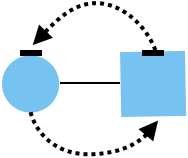
When a wheel around is done at the end of another figure (e.g., at the end of a right and left though or a robin’s chain), it is called a courtesy turn. In the courtesy turn version, the lark takes the robin’s left hand his, scoops around them puts his R hand behind their waist and backs up in a wheel around.
Up next are a number of moves where the dancers rotate in different directions and end up swapping places (and often end up facing different directions). The first of these is known as the California twirl. In this move, the dancers start side by side holding inside hands. The robin turns halfway counterclockwise under the joined hands into her partner’s position, while the lark traces a clockwise half circle around the outside of the turning robin, to end up in her position. Both end facing the reverse direction (figure 25.31).

The square dance move called partner trade (figure 25.32) is the same as California twirl, except without holding hands.

The square dance move called star through is effectively the same as a California twirl, except you start facing your partner rather than next to them. The couple is holding the lark’s right hand and the robin’s left hand. You trace the same pathway as the California twirl (figure 25.33). You both end up facing the same direction, side by side, 90° rotated from where you started (figure 34).


A slide through is the same thing as a star through but without holding hands (figure 25.35)

There are some other exchanging position figures that start facing your partner. The box the gnat is like the star through with two important differences. First, you hold right hands instead of inside hands. Second, in a star through, you end side by side with your partner, but in a box the gnat you end facing your partner again (compare figure 25.37 to figure 25.34).


It’s also possible to do the same motion as box the gnat but holding L hands and rotating the opposite directions. This is called either swap the flea or swat the flea (Figure 25.38).

<insert video of California twirl, box the gnat etc.>
- Wheel around: Dancers start side by side, looking in the same direction and holding inside hands. You swap places and swap the direction you are facing by doing wheel around. In this move, the lark backs up while the robin dances forward, creating a counterclockwise rotation.
- Courtesy turn (contra and square): The lark takes the robin’s left hand in his, scoops around them putting his R hand behind their waist. The lark backs up and the robin dances forward to rotate halfway around counterclockwise in a wheel around.
- California twirl: The dancers start side by side, facing the same direction and holding inside hands. The robin turns halfway counterclockwise under the joined hands into her partner’s position, while the lark traces a clockwise circle around the outside of the turning robin, to end up in her position. Both end facing the other direction.
- Partner trade (square dance): The same as California twirl, except not holding hands.
- Star through: This is the same motion as a California twirl, except you start facing your partner. The couple is holding the lark’s right hand and the robin’s left hand. You both end up facing the same direction, side by side, 90° rotated from where you started.
- Slide through: The same as a star through but not holding hands.
- Box the gnat: Holding right hands and facing each other. The dancers exchange places, with the follower turning counterclockwise under the joined hands into partner’s place while the leader walks around them clockwise into their place.
- Swap the flea/Swat the flea: Holding left hands and facing each other. The dancers exchange places, with the follower turning clockwise under the joined hands into partner’s place while the leader walks around them counterclockwise into their place. This is the same as a box the gnat but instead holding left hands and walking in the opposite directions.
1.7. Figures That Move You and Your Partner Around a Space.
Now we turn to some figures that move you around a defined space in a set dance. The first of these is the promenade: A promenade is simply walking forward in some direction together with your partner. A wide variety of hand holds can be used. The promenade is often used to rotate couples around a big circle or around a square.
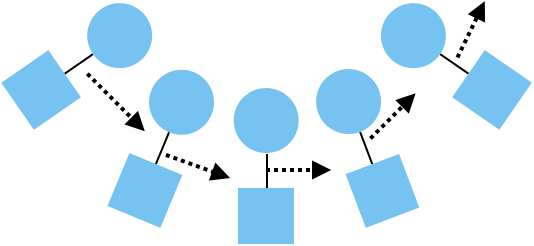
A variant of the promenade also moves the couple forward in line of direction, but it’s done with the couple alternately dancing back to back and face to face. In figure 25.40, the joined inside hands are thrust forward, so that the dancers are back to back, the lark steps to their right on the right foot and the robin steps on their left to the left. Then on the next bar, the dancers swing their joined hands backwards, so they end up face-to-face with their partner, while stepping forward in LOD on lark’s left and robin’s right.
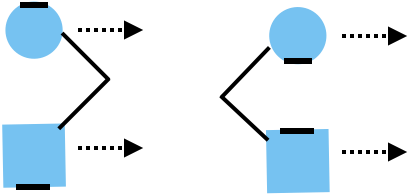
In set dances there’s a variation of the promenade where the top couple leads down the center. This is typically followed by the same couple turning around and dancing back up to the top.
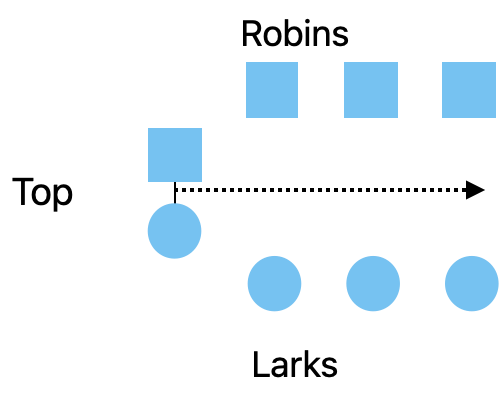
In Scottish and English country dancing, going down the outside of the set is called casting off or cast down. In a cast off, you separate from your partner, always pulling the shoulder closest to the top backwards, then you dance by yourself down behind your own line on the outside. The reverse motion back up to the top is called a cast up.
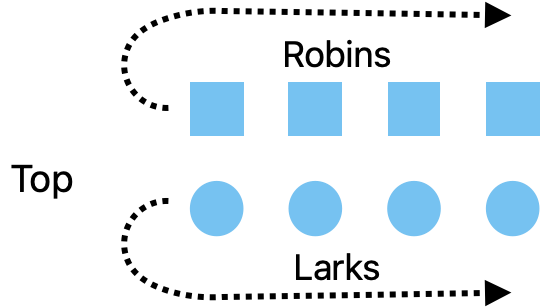
The term cast off has a slightly different meaning in contra dancing. The cast off in contra dancing often happens after the top/active couple has danced down the center and come back up. When they reach the top the second/inactive couple grabs them around the waist, and they do a three quarters wheel around (robins rotating clockwise and the larks rotating counterclockwise) to end in a progressed position with the inactive couple at the top and the active couple below (Figure 25.43).

<insert Video promenade etc.>
- Promenade: A promenade is simply walking forward in some direction next to your partner.
- Back to back and Face to Face: The joined inside hands are thrust forward, so that the dancers are back to back. The lark steps to their right on the right foot and the robin steps on their left to the left. Then on the next bar, the dancers swing their joined hands backwards, so they end up face to face with their partner, while stepping in LOD on lark’s left and robin’s right.
- Lead down the center: The top couple take hands and promenade down the center of the longwise set. Typically, they turn and dance back up to the top.
- Cast down/Cast off (Scottish/English): Dancing away from the center of the set (and away from partner) pull outside shoulder back (Robin’s right; Lark’s left) and turn away, then dance down the back/outside of you own line to a position lower down the set (typically either to the next position or to the bottom of the set).
- Cast up: Same as a cast off, except you move towards the top of the set on the outside rather than dancing down.
- Cast off (Contra): After coming back up after a lead down the active and inactive couple grabs the waist of the person on the same side of the dance, and everyone does a three quarters wheel around (robins rotating clockwise and the larks rotating counterclockwise) to end in a progressed position with the inactive couple at the top and the active couple below.
2. Figures For at Least Four People
2.1. Four Person Figures in Lines
In section 1.7, we saw lead down the center for a couple. You can also have this for lines of four, which is unsurprisingly called lines of 4 down the hall. These lines can, of course, also dance up the hall.
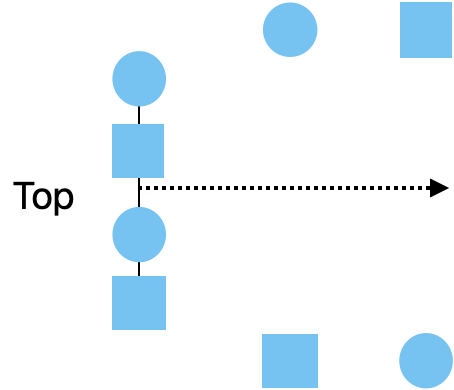
When a line of 4 reaches the top of a set after dancing down and back, it can get back into facing couples, by doing a move called bend the line. When you bend the line, the two ends of the line fold inwards and the line “breaks” in the middle.

- Four in line down the hall and back: The same as lead down the center and back but done as a line 4 instead of just a couple.
- Bend the line: After a 4 in line down the hall, the ends of the line fold inwards while the centers back up , breaking the line in the center. The move either ends with couples facing or in a closed circle.
2.2. Circles
One of the most basic figures found in set, contra and square dances dances is the circle. Typically, you take hands with the rest of your group, and you rotate either clockwise, circle to the left (Figure 46) or counterclockwise, circle to the right (figure 25.47). The footwork in a circle varies depending upon the style of dancing you are doing. It can be walking, sashay steps, or buzz steps.
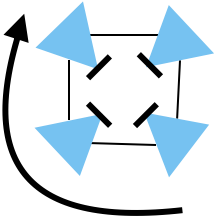
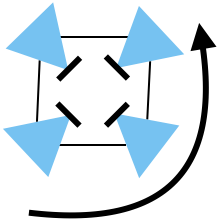
To indicate how many people are involved in the circle, you will often hear people say X hands round. 4 hands round is for four people (even though there are 8 actual limbs involved!). 6 hands round means 6 people. 8 hands round means 8. etc. Figure 25.48 is a circle L, 8 hands round.
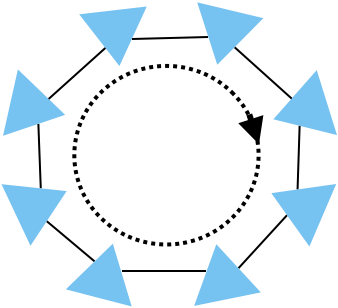
An interesting variation on the circle is the petronella turn. Just like a more traditional circle it causes the dancers to rotate round a circle, but it does so with the dancers spinning around on their own axis as they rotate around the larger circle, taking the place of the person next to them. Petronella turns almost always rotate the group counterclockwise, while each dancer spins or rolls CW into the position of the person to their right. The figure of is interspersed with a balance or a setting step before each rotation to the R into your neighbors place.
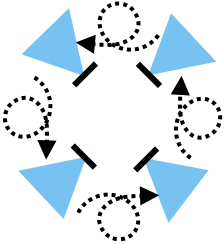
We end our discussion of circles with a figure that transitions from a circle into a line. It is unimaginatively called circle to a line. In this figure, after circling clockwise for a while, one dancer drops their R hand and then leads the line out into a straight line.
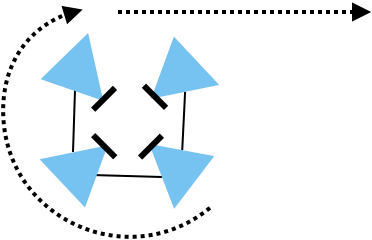
<insert video of various circle moves>
- Circle L: Take hands with your neighbors and rotate the group in a circle in a clockwise direction.
- Circle R: Take hands with your neighbors and rotate the group in a circle in a counterclockwise direction.
- X Hands Round: In circling, X hand round means the circle involves X number of people. So, 4 hands round involves 4 people circling, 6 hands round involves 6 people, etc.
- Petronella Turn: A special kind of counterclockwise rotation for four people, where each dancer spins clockwise into their R hand neighbors position. Each turn is typically preceded by a setting step or balance.
- Circle to a line: One dancer drops hands with their neighbor and leads the dancers in a circle into a straight line.
2.3. Stars/Hands Across
The other very common figure for four people is known either as a star (square and contra dancing) or hands across (country dancing). In these figures, the 4 dancers put one hand into the center, and then rotate around those joined hands. Depending upon the style of dancing, different handholds can be used. When you put your R hands into the center (figure 25.51), everyone faces clockwise, and the circle rotates clockwise. When you put your L hand into the center (figure 25.52), you face counterclockwise and rotate around the center point counterclockwise.
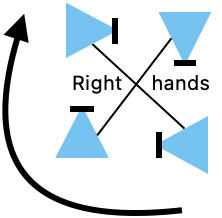
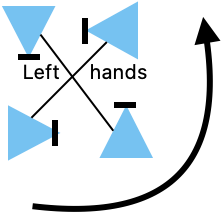
It’s actually possible to do star figures with 8 people too. When you do this, it’s called a star promenade. The four people in middle form a star and their partners on the outside promenade forward with them.
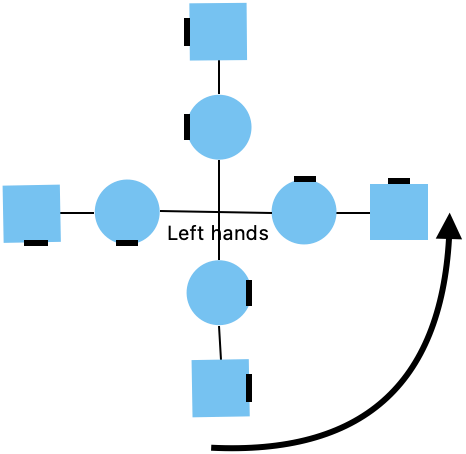
A variant on the star promenade is the thar (sometimes called a backup thar). In the thar, the two partners face different directions, and the one in the center holding hands backs up rather than dancing forward.
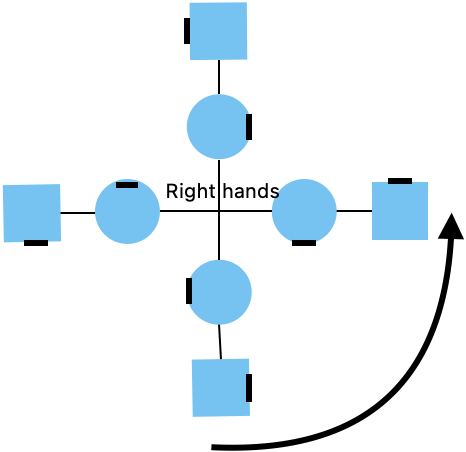
<insert video of stars and thars>
- R hand star (right hands across): The dancers put their R hand into the center, face clockwise and rotate the group clockwise.
- L hand star (left hands across): The dancers put their L hand into the center, face counterclockwise and rotate the group counterclockwise.
- Star Promenade: A star but done as couples instead of individual dancers. One member of each couple puts one hand into the center and the other member promenades with them as the star rotates.
- Thar (back up thar): A variant on the star promenade, where the members of the couple face opposite directions. The center member of each couple, backs up instead of dancing forward.
2.4 Rights and Lefts, Right and Left Through, Chains.
Circles and stars are among the oldest set dance figures. Two other very old figures that are found in country, contra and square dance are figures variously known as rights and lefts, right and left through, square through and robin’s chain.
Rights and lefts in country dancing, known as square through in square dancing, starts by both dancers pulling by their opposite by giving them a right hand (figure 25.55). Then they turn to face their partner on the opposite side and pull by their partner with the L hand (figure 25.56). The figure can then optionally be repeated back to place. In a square dance, the square through is often called with a specific number of hand changes (i.e., “square through 3”, means giving right hand to your opposite;7 L hand to your partner; and then R hand to your opposite again).


The right and left through figure found in contra dancing and square dancing is clearly related but has a different part 2. As in rights and lefts you start by pulling by your opposite with the R hand (i.e. figure 25.55 above), but instead of turning to face your partner, you stay facing the same direction as when you pulled by. You take L hand in L hand and do a courtesy turn (a wheel around) as in figure 25.57 to end facing the opposite couple on the other side:

The dance may then have the couples right and left through back home or do a different movement from the new position.
The Ladies chain (now more commonly known as the Robins chain) is another related figure. In this movement, only the robins exchange places. The robins give each other a right hand and pull by each other, while the larks step to the right into their partners’ place. In square and contra dancing, the lark takes the left hand of the robin stepping towards them and folds in with their right hand on the robin’s R hip and scoops them up into a courtesy turn. In Scottish and English country dancing the courtesy turn is often replaced by a left hand turn.
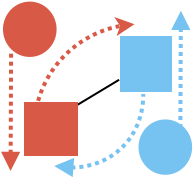
<insert video of R&L and chain>
- Rights and Lefts (Country dance)/Square through (Square dance): Give right hands to your opposite and pull by/make a ½ turn. Make a ¼ turn to face your partner on the opposite side and pull by/ ½ turn with the L.
- Right and Left Through (Square and Contra): Give R hands to your opposite and pull by. Facing out on the opposite side, take L hands with partner; lark puts right hand on partner’s R hip and do a courtesy turn (i.e. a wheel around with the lark backing up).
- Robin’s chain (Ladies chain): Robins give each other their right hand and pull by, while larks slide to the right in their partner’s place. Larks give left hand to the robin dancing towards them. In contra and square dancing, the lark folds inward and puts right hand across opposite’s back and onto her right hip to wheel around in a courtesy turn. In country dancing, they turn by the left ½ way instead. Repeat back to place for a full robin’s chain (although in most modern dances you only dance the half figure described here).
2.5. Other Figures for 4 People
There is a figure that resembles a dosido but is done by couples acting together as if they were individual dancers. This is called a poussette. In contra dancing and in English country dancing, this is done by taking two hands with partner and moving clockwise around the other couple. The active lark passes back to back with the inactive robin. You don’t turn around, and you end in the other couple’s position.
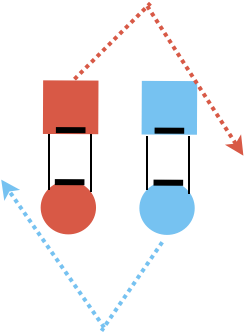
This version of the poussette can also be done with the opposite (counterclockwise) rotation.
The Scottish country dance version of the poussette is a little more complicated stylistically. In this style of dance, the inactive couple (couple 2), takes two hands with partner and dance towards the robin’s line, while the active couple take two hands and dance towards the lark’s line. The couples then rotate ¼ clockwise in place. Then with inactive lark and the active robin backing up, the couples move up and down the line. They then make another ¼ clockwise turn. Still with the inactive lark and the active robin backing up. they dance into the center having switched places with the other couple (figure 25.60). Both couples then make a ½ clockwise turn to end on original sides (figure 25.61), drop hands and back away from their partner. This has the same net effect as the English and contra poussette because the couples have switched places. The main difference is that they don’t pass back-to-back. But still rotate around each other. In the Scottish version the overall rotation of the couples is counterclockwise.
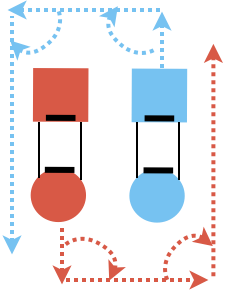
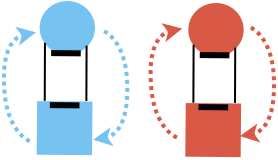
Dive through is another figure that switches the positions of two couple. One couple forms a high arch with their joined inside hands. The other couple gets close together and dives through (or ducks through) under the arch, while the couple doing the arch dances forward over the diving couple. Once the couples have exchanged places, they sometimes finish with a courtesy turn or California Twirl, or they do another figure with another on-coming couple.
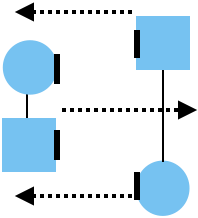
Next, we have a series of figures that trace some version of a figure eight on the floor. The most straightforward of these is the figure known as a figure eight. In the basic form of this movement, the inactive couple stands stationary and acts as the poles around which the active couple traces the pathway. Typically speaking this starts with both members of the active couple dancing down between the inactive couple, with the lark letting the robin cross in front. The active lark then loops up counterclockwise around the inactive robin and the active robin loops up clockwise around the inactive lark. The motion can stop there, with the active couple in their original positions but on opposite sides of the set. This is known as a half figure eight. But it can also be done where the motion continues and the active couple dances down between the inactive couple for a second time, again with the active robin crossing in front of the active lark. The active robin then loops counterclockwise around the inactive robin and the active lark loops clockwise around the inactive lark. Thus, in the full figure of eight the active couple ends up where they originally started.
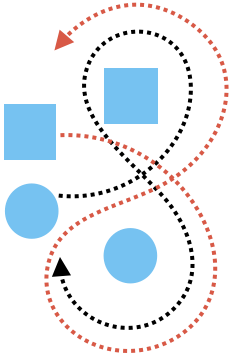
Perhaps the most common kind of looping in and out figure is called either a reel (in Scottish dancing) or a hey (in other kinds of dancing). These can be done a variety of ways, but one common way is known as the right shoulder reel/hey for 4. The characteristic pattern of heys is that all the dancers are moving at once and they trace a figure eight on the floor, but with an extra little loop in the middle. The hey starts by the people in the middle passing right shoulders with the people on the outside (figure 25.64). Next the dancers who have just danced outward, pull their right shoulders back and make a little loop on the end while the dancers who moved inwards pass each other by the left shoulder giving the extra loop in the middle. Then the pathway is repeated with the new inside dancers passing R shoulders with the outside dancers (figure 25.65).
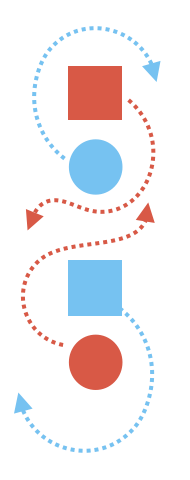

Heys can also be started passing left shoulder with the outside dancer, where the motion is the opposite of figure 25.65.
There are no heys in square dancing, however they have a figure which is similar but involves a sequence of hand turns. This is called a swing through. In this pattern, the dancers are alternately facing different directions (known as an ocean wave formation). It starts by turning whoever is in your right hand halfway (figure 25.66). Then you turn the next person by the left if you can (figure 25.67). This sequence can be repeated. While this figure involves hand turning it has an effect similar to a hey in that the dancers alternately loop around each other.


<insert video(s) of heys, figure 8, poussette, swing through>
- Poussette (Contra and English): Essentially a dosido or see-saw but done as a couple. The couples rotate around each other exchanging places.
- Poussette (Scottish): Two couples exchange place. Holding two hands, the active couple moves towards lark’s line; inactives move towards robin’s line. Each couple rotate ¼ CW, then the inactives dance up the robin’s line and the actives dance down the larks line. Each couple then rotates a ¼ CW again and dances into the center having exchanged places with the other couple. Each couple then rotates ½ CW to return to original sides, and backs into their original lines.
- Dive through: One couple forms a high arch with their joined inside hands. The other couple gets close together and dives through (or ducks through) under the arch, while the couple doing the arch dances forward over the diving couple. Once the couples have exchanged places, they sometimes finish with a courtesy turn or California Twirl, or they do another figure with another on coming couple
- Figure Eight: both members of the active couple dancing down between the inactive couple, with the lark letting the robin cross in front of him. The active lark then loops up counterclockwise around the inactive robin and the active robin loops up clockwise around the inactive lark. Then repeat back to original position, dancing around the other member of the inactive couple.
- Hey for 4 (Reel for 4): The hey starts by the people in the middle passing right shoulders with the people on the outside. Next the dancers who have just danced outward, pull their right shoulders back and make a little loop on the end while the dancers who moved inwards pass each other by the left shoulder giving the extra loop in the middle. Then the pathway is repeated with the new inside dancers passing R shoulders with the outside dancers.
- Swing through. the dancers are alternately facing different directions (known as an ocean wave formation). It starts by turning whoever is in your right hand halfway. Then turn the next person by the left if you can.
3. Figures for Three People
Many of the moves for three people are related to moves for two people. For example, there are three-person equivalents to the inside turn and the outside turn. In a double inside turn, the two ends both turn towards the center person and turn under the joined hands. In a double outside turn, the two ends turn away from center and under joined hands.


The double roll-up turn has both ends rolling in with arms are kept low, wrapping the arms around them. The trio ends up in a double sweetheart position. The double roll-out turn has the outside dances unfurling from a double sweetheart position by turning outwards with arms low.
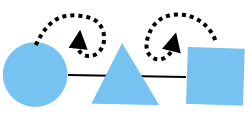
<insert video of trio turns>
- Double inside turn: In a trio, both ends turn towards the center person and turn under their own joined hands.
- Double outside turn: In a trio, both ends turn away from center person and then turn under the joined hands.
- Double roll in turn: In a trio, both ends rolling in with arms are kept low, wrapping the arms around them. The trio ends up in a double sweetheart position.
- Double roll out turn: In a trio, starting in a double sweetheart position, the two ends unfurl (roll outwards away from center person) in with arms are kept low.
There are also several four-person figures that can also be done with just three people. For example, you can do circles and stars (figure 25.71) with just three people. In Scottish country dancing, a three person star or hands across is mysteriously informally called a teapot.
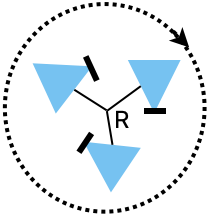
Similarly, a reel or hey can be done with just three people. The hey for three is a figure 8 pattern where everyone moves at the same time tracing a figure eight on the floor. Unlike a hey for 4, there isn’t an extra loop in the middle (figures 25.72 and 25.73). The hey for three can be done with the center starting passing right shoulders with one of their neighbors as in the diagrams below. Or it can be done starting by passing left shoulders with the opposite direction of rotation. The hey involves alternatively passing the other dancers with the right shoulder and then the left.
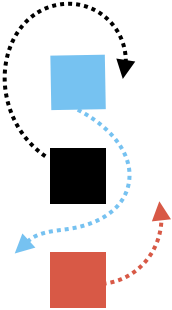

A common figure in dances with trios has the members of the group alternately turning each other. The trio swing through starts with the center person (cuckoo), exchanging places with the robin by the R hand (figure 25.74), then the person in the middle (now the robin) turns the lark by the left (figure 25.75). This can be repeated until everyone gets home.
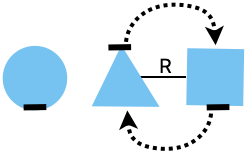

In the swing through all the turns are just halfway around exchanging places with your neighbors. The trio rights and lefts involves a full turn with each person in succession. So, in figure 25.76, the cuckoo turns the robin all the way around with the right hand, then in figure 25.77, they turn the lark all the way around by the L.


Finally, we have a figure that is unique to trios. This is the through the arch pattern. Here, the cuckoo raises one of their arms (in the case of figure 25.78, this is the L arms) and the robin on the other side dances through under the arch formed by the cuckoo and the lark (marked as (1) in figure 25.78). The lark then follows through under the arch themselves (marked as (2) in figure 25.78). This is then typically followed by the same pattern being repeated, where the cuckoo raises their other hand, and the other dancer ducks through, followed by the cuckoo.
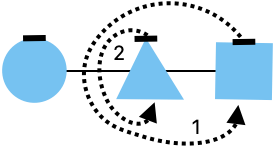
<insert video of three person moves>
- Three person stars (Teapots): Done in trios, the dancers put either their R or L hand into the center and rotate the trio clockwise or counterclockwise.
- Hey for three/Reel of three: A figure 8 pattern where everyone moves at the same time tracing a figure eight on the floor. In a right shoulder hey for three, the center starts passing right shoulders with one of their neighbors, then they loop around the end while the other two dancers pass left shoulders in the middle. The pattern can also be done starting left shoulders with the opposite direction of rotation.
- Swing through for three: The center person (cuckoo), exchanges places with the robin by turning them with the right hand ½ way. Then the robin, now in the center turns the lark ½ way by the left. And so on.
- Trio rights or lefts: The center person (cuckoo), turns the robin all the way around by the R hand and then turns the lark all the way around by the left.
- Through the arch: The cuckoo raises the hand joined with the lark and the robin on the other side dances through under the arch. The lark then follows through under the arch themselves. This is then typically followed by the same pattern being repeated with the lark dancing under an arch formed with the robin.
4. Figures for Six or Eight People
We already discussed the normal robins chain figure above. The four robins chain is an interesting variation found in square sets. In this figure, like the basic robin’s chain, the robins cross over to the other side, where they are turned in a courtesy turn by the opposite lark. But here, four robins are involved, they cross over, not just by pulling by, but by doing a right hand star in the middle.

Perhaps the most famous square dance figure is the grand right and left (also called a right and left grand). In this figure all 8 dancers are moving around the circle. The larks travel counterclockwise, and the robins consistently travel clockwise. You start by giving your partner your right hand and pull by them (figure 25.80). Then give the next person you meet your left and pull by again (figure 25.81). Repeat this until you meet your partner again (or continue around until you get home). You never turn around and go the opposite way.

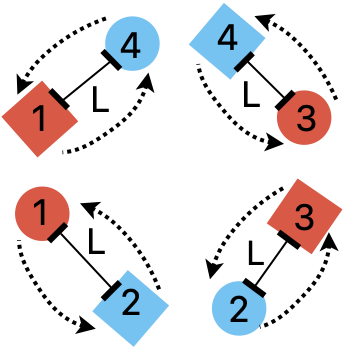
Wrong way grand is almost the same as a grand right and left, except the larks circulate clockwise and the robins circulate counterclockwise. Weave the ring is another variant form of the grand right and left. It is essentially an identical pattern, except you don’t take hands and pull by, you just alternately pass right and left shoulders as you work around the square.
Grand square is an impressive looking figure, but once you understand the basic rules it’s really quite straight-forward. In this figure both the head couples and the sides are moving at the same time. They are essentially tracing the same pathways, but with different timing. The call often starts with “sides face” and the sides turn to face each other. The head couples face across. The general rule of thumb is if you are far apart from the person you are facing, then you dance forward. If you’re close to the person you’re facing, then back up. You make a ¼ turn every time you finish a movement. Let’s start by mapping out the pathway taken by the heads (figure 25.82). Here the heads advance towards their opposite (arrow 1 in the figure). Then the make a ¼ turn to face their partner. Then because they are close to the person they are facing, they back away (along the 2 arrow). They are now in the side couple’s position. Next, they make another ¼ turn (larks turn counterclockwise, robins turn clockwise to face their opposite again). Now they back away from their opposite (arrow 3). Another ¼ turn, this time to face their partner, and they advance towards their partner ending in their original places facing their partner (arrow 4). The figure is now repeated in reverse; they start by backing up and retracing their previous paths. If you look carefully at figure 25.82, you’ll see that each dancer traces a small square in their own quadrant of the square.
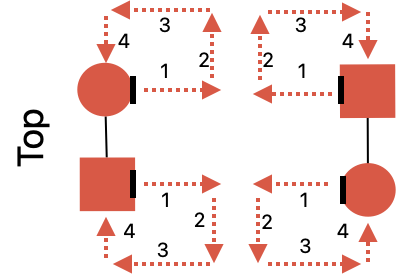
The path taken by the sides is essentially identical to that of the heads, but off cycle by 50%. They start by backing away from their partner (1), they turn a ¼ to face their opposite and then advance towards their opposite (2). Turn a ¼ to face in, advance into the center towards their partner (3). Turn ¼ so they are side by side with their partner and back up into their original places (4). Then the pattern is reversed. The heads and the sides are all moving at the same time.
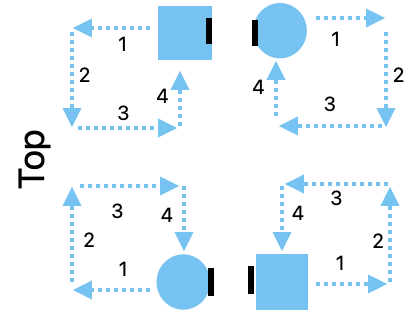
Contra corners is a sequence where you turn your partner by the right hand, then you turn your first corner by the left hand, then your partner by the right hand and then your second corner by the left hand.

<insert video(s) of 4 Robins chain, Grand Right and Left etc.>
- Four Robins’ chain: The four robins do a ½ R hand star in the middle of a square, while larks shift to their right into their partner’s place. Then the robin gives the opposite lark their L hand. Larks take robin with the R and then fold in behind them and put R hand on R hip. Then they wheel around counterclockwise (lark backing up) in a courtesy turn. Then you can repeat back to place.
- Grand Right and Left: In a square, give partner R hand and pull by. Then give the next person you meet your left and pull by again, repeat until you meet your partner again (or continue around until you get home). Larks rotate counterclockwise. Robins rotate clockwise
- Wrong way grand: This is the same as a grand right and left, except the larks circulate clockwise and the robins circulate counterclockwise.
- Weave the ring: This is the same as a grand right and left, except you don’t take hands, you just alternately pass right and left shoulders as you work around the square.
- Grand Square: Sides start facing their partners; heads face the center. Heads advance into the center, while sides back away from partner. Heads ¼ turn to face partner; sides ¼ turn to face opposite. Heads retire back into sides position; sides advance into head position. Heads turn a ¼ to face opposite on the sides; Sides ¼ turn to face partner across the square. Sides advance into the center, while heads back away from opposite on the sides. One more ¼ turn, heads face partner; sides face opposite. Heads advance towards their original position. Sides back into their original position. Then repeat the whole thing except reversing direction.
- Contra corners: The active couple turns their partner by the right, then they turn your own respective first corner by the left. This is followed by another partner turn by the right and then a turn by the left of the second corner.
There are many other figures for 6 or 8 people, so this section has just been designed to give you a taste of some of the more common ones.
5. Resources for other Specialized Figures
In this chapter, I’ve covered some fairly common figures found in couple, square, contra and country dance formations. But there are many more figures than what I’ve listed here. In square dancing for example, there are literally hundreds and hundreds of further figures and patterns. Fortunately, there are some excellent resources out there to cover figures I haven’t discussed in this chapter. These are listed in the further reading section below.
Further Reading
Contra Dance Resources
- https://www.cdss.org/elibrary/dart/appendix_b.htm
- https://contrafusion.co.uk
- https://en.wikipedia.org/wiki/Contra_dance_choreography
- https://www.ibiblio.org/contradance/thecallersbox/Glossary.htm
Scottish Country Dance Resources
- https://www.scottish-country-dancing-dictionary.com
- https://rscds.org/learn/steps-techniques/formations
- http://www.scottishdance.net/scd/technique/Figures.html
English Country Dance Resources
- https://colinhume.com/dt.htm
- https://round.soc.srcf.net/dances/elements
- https://en.wikipedia.org/wiki/Glossary_of_country_dance_terms
- https://www.apricotfolk.co.uk/Country%20Dancing%20-%20Dancing%20Terms%20Explained.html
Square Dance Resources
- https://callerlab.org/download/community-dance-program-list-94-05-01rev-09-11-18/
- https://callerlab.org/download/social-square-dancing-teaching-guide/
- https://callerlab.org/download/basic-program-definitions/
- https://callerlab.org/download/mainstream-program-definitions/
- https://callerlab.org/download/advanced-definitions/
- https://callerlab.org/download/c-1-definitions/
- https://callerlab.org/download/c-2-definitions/
- https://callerlab.org/download/c-3a-definitions/
- Cyberpoint video lesson: https://youtube.com/@cyberpoint?si=DYIZC4–AGz5fgoJ
- Visualizations Square dance figures https://www.dehnbase.org/sd/tutorial/
[1] In the dances of Germany and Eastern Europe one occasionally even finds choreographed cheek kisses. These are generally frowned upon in recreational dances of Western Europe and North America and are now largely limited to stage performances where a story is being told with the dance.
Media Attributions
- Figure 25.1: Turn single © Andrew Carnie is licensed under a CC BY-NC-SA (Attribution NonCommercial ShareAlike) license
- Figure 25.2: Turn alone/U turn © Andrew Carnie is licensed under a CC BY-NC-SA (Attribution NonCommercial ShareAlike) license
- Figure 25.3: Solo advance and retire/forward and back © Andrew Carnie is licensed under a CC BY-NC-SA (Attribution NonCommercial ShareAlike) license
- Figure 25.4: Couples advance and retire/forward and back © Andrew Carnie is licensed under a CC BY-NC-SA (Attribution NonCommercial ShareAlike) license
- Figure 25.5: Long lines forward and back © Andrew Carnie is licensed under a CC BY-NC-SA (Attribution NonCommercial ShareAlike) license
- Figure 25.6: Up a double © Andrew Carnie is licensed under a CC BY-NC-SA (Attribution NonCommercial ShareAlike) license
- Figure 25.7: Siding © Andrew Carnie is licensed under a CC BY-NC-SA (Attribution NonCommercial ShareAlike) license
- Figure 25.8: Inside under arm turn, nearer hands held © Andrew Carnie is licensed under a CC BY-NC-SA (Attribution NonCommercial ShareAlike) license
- Figure 25.9: Counterclockwise inside turn, R hands held © Andrew Carnie is licensed under a CC BY-NC-SA (Attribution NonCommercial ShareAlike) license
- Figure 25.10: Outside under arm turn, nearer hands held © Andrew Carnie is licensed under a CC BY-NC-SA (Attribution NonCommercial ShareAlike) license
- Figure 25.11: Clockwise outside turn, R hands joined © Andrew Carnie is licensed under a CC BY-NC-SA (Attribution NonCommercial ShareAlike) license
- Figure 25.12: Round the world © Andrew Carnie is licensed under a CC BY-NC-SA (Attribution NonCommercial ShareAlike) license
- Figure 25,13: Roll/Roll up © Andrew Carnie is licensed under a CC BY-NC-SA (Attribution NonCommercial ShareAlike) license
- Figure 25.14: ½ R hand turn © Andrew Carnie is licensed under a CC BY-NC-SA (Attribution NonCommercial ShareAlike) license
- Figure 25.15: ½ L hand turn © Andrew Carnie is licensed under a CC BY-NC-SA (Attribution NonCommercial ShareAlike) license
- Figure 25.16: clockwise two hand turn © Andrew Carnie is licensed under a CC BY-NC-SA (Attribution NonCommercial ShareAlike) license
- Figure 25.17: walk around (formerly called gypsy) © Andrew Carnie is licensed under a CC BY-NC-SA (Attribution NonCommercial ShareAlike) license
- Figure 25.18: Dosido/Back to Back/Dosado © Andrew Carnie is licensed under a CC BY-NC-SA (Attribution NonCommercial ShareAlike) license
- Figure 25.19: Seesaw © Andrew Carnie is licensed under a CC BY-NC-SA (Attribution NonCommercial ShareAlike) license
- Figure 25.20: clockwise mad robin © Andrew Carnie is licensed under a CC BY-NC-SA (Attribution NonCommercial ShareAlike) license
- Figure 25.21: Pass through © Andrew Carnie is licensed under a CC BY-NC-SA (Attribution NonCommercial ShareAlike) license
- Figure 25.22: Pull by © Andrew Carnie is licensed under a CC BY-NC-SA (Attribution NonCommercial ShareAlike) license
- Figure 25.23: Change places © Andrew Carnie is licensed under a CC BY-NC-SA (Attribution NonCommercial ShareAlike) license
- Figure 25.24: Slide across © Andrew Carnie is licensed under a CC BY-NC-SA (Attribution NonCommercial ShareAlike) license
- Figure 25.25: Ending position for slide across © Andrew Carnie is licensed under a CC BY-NC-SA (Attribution NonCommercial ShareAlike) license
- Figure 25.26: Half sashay © Andrew Carnie is licensed under a CC BY-NC-SA (Attribution NonCommercial ShareAlike) license
- Figure 25.27: Roll-away with a half sashay © Andrew Carnie is licensed under a CC BY-NC-SA (Attribution NonCommercial ShareAlike) license
- Figure 25.28: Double roll-away © Andrew Carnie is licensed under a CC BY-NC-SA (Attribution NonCommercial ShareAlike) license
- Figure 25.29: Larks run (square dance figure) © Andrew Carnie is licensed under a CC BY-NC-SA (Attribution NonCommercial ShareAlike) license
- Figure 25.30: Wheel Around © Andrew Carnie is licensed under a CC BY-NC-SA (Attribution NonCommercial ShareAlike) license
- Figure 25.31. California twirl © Andrew Carnie is licensed under a CC BY-NC-SA (Attribution NonCommercial ShareAlike) license
- Figure 25.32: Partner trade © Andrew Carnie is licensed under a CC BY-NC-SA (Attribution NonCommercial ShareAlike) license
- Figure 25.33: Star through motion © Andrew Carnie is licensed under a CC BY-NC-SA (Attribution NonCommercial ShareAlike) license
- Figure 25.34: Star through ending position © Andrew Carnie is licensed under a CC BY-NC-SA (Attribution NonCommercial ShareAlike) license
- Figure 25.35: Slide through © Andrew Carnie is licensed under a CC BY-NC-SA (Attribution NonCommercial ShareAlike) license
- Figure 25.36: Box the gnat motion © Andrew Carnie is licensed under a CC BY-NC-SA (Attribution NonCommercial ShareAlike) license
- Figure 25.37: Box the gnat ending position © Andrew Carnie is licensed under a CC BY-NC-SA (Attribution NonCommercial ShareAlike) license
- Figure 25.38: Swat the flea © Andrew Carnie is licensed under a CC BY-NC-SA (Attribution NonCommercial ShareAlike) license
- Figure 25.39: Promenade © Andrew Carnie is licensed under a CC BY-NC-SA (Attribution NonCommercial ShareAlike) license
- Figure 25.40: Back to back, face to face © Andrew Carnie is licensed under a CC BY-NC-SA (Attribution NonCommercial ShareAlike) license
- Figure 25.41: Lead down the center © Andrew Carnie is licensed under a CC BY-NC-SA (Attribution NonCommercial ShareAlike) license
- Figure 25.42: Cast down (Scottish/English) © Andrew Carnie is licensed under a CC BY-NC-SA (Attribution NonCommercial ShareAlike) license
- Figure 25.43: Cast off (Contra) © Andrew Carnie is licensed under a CC BY-NC-SA (Attribution NonCommercial ShareAlike) license
- Figure 25.44: Lines of 4 down the center © Andrew Carnie is licensed under a CC BY-NC-SA (Attribution NonCommercial ShareAlike) license
- Figure 25.45: Bend the line (Contra) © Andrew Carnie is licensed under a CC BY-NC-SA (Attribution NonCommercial ShareAlike) license
- Figure 25.46: Circle L © Andrew Carnie is licensed under a CC BY-NC-SA (Attribution NonCommercial ShareAlike) license
- Figure 25.47: Circle R © Andrew Carnie is licensed under a CC BY-NC-SA (Attribution NonCommercial ShareAlike) license
- Figure 25.48: Circle L 8 hands round © Andrew Carnie is licensed under a CC BY-NC-SA (Attribution NonCommercial ShareAlike) license
- Figure 25.49: Petronella turn © Andrew Carnie is licensed under a CC BY-NC-SA (Attribution NonCommercial ShareAlike) license
- Figure 25.50: Circle to a line © Andrew Carnie is licensed under a CC BY-NC-SA (Attribution NonCommercial ShareAlike) license
- Figure 25.51: R-hand star (R hands across) © Andrew Carnie is licensed under a CC BY-NC-SA (Attribution NonCommercial ShareAlike) license
- Figure 25.52: L-hand star (L hands across) © Andrew Carnie is licensed under a CC BY-NC-SA (Attribution NonCommercial ShareAlike) license
- Figure 25.53: L hand star promenade © Andrew Carnie is licensed under a CC BY-NC-SA (Attribution NonCommercial ShareAlike) license
- Figure 25.54: Back up thar © Andrew Carnie is licensed under a CC BY-NC-SA (Attribution NonCommercial ShareAlike) license
- Figure 25.55: Rights and Lefts, part 1 © Andrew Carnie is licensed under a CC BY-NC-SA (Attribution NonCommercial ShareAlike) license
- Figure 25.56: Rights and Lefts, part 2 © Andrew Carnie is licensed under a CC BY-NC-SA (Attribution NonCommercial ShareAlike) license
- Figure 25.57: Right and left through, part 2 (courtesy turn) © Andrew Carnie is licensed under a CC BY-NC-SA (Attribution NonCommercial ShareAlike) license
- Figure 25.58: Robin’s chain part 1 © Andrew Carnie is licensed under a CC BY-NC-SA (Attribution NonCommercial ShareAlike) license
- Figure 25.59: (Half) Poussette (English/Contra) © Andrew Carnie is licensed under a CC BY-NC-SA (Attribution NonCommercial ShareAlike) license
- Figure 25.60: Poussette (Scottish) Part 1 © Andrew Carnie is licensed under a CC BY-NC-SA (Attribution NonCommercial ShareAlike) license
- Figure 25.61: Poussette (Scottish) Part 2 © Andrew Carnie is licensed under a CC BY-NC-SA (Attribution NonCommercial ShareAlike) license
- Figure 25.62: Dive through © Andrew Carnie is licensed under a CC BY-NC-SA (Attribution NonCommercial ShareAlike) license
- Figure 25.63: Figure Eight © Andrew Carnie is licensed under a CC BY-NC-SA (Attribution NonCommercial ShareAlike) license
- Figure 25.64: First part of right shoulder reel of 4 © Andrew Carnie is licensed under a CC BY-NC-SA (Attribution NonCommercial ShareAlike) license
- Figure 25.65: Pathway in a reel/hay for 4 © Andrew Carnie is licensed under a CC BY-NC-SA (Attribution NonCommercial ShareAlike) license
- Figure 25.66: Swing through, first turn by the right © Andrew Carnie is licensed under a CC BY-NC-SA (Attribution NonCommercial ShareAlike) license
- Figure 25.67: Swing through, next turn by the left if you can © Andrew Carnie is licensed under a CC BY-NC-SA (Attribution NonCommercial ShareAlike) license
- Figure 25.68. Double inside turn © Andrew Carnie is licensed under a CC BY-NC-SA (Attribution NonCommercial ShareAlike) license
- Figure 25.69: Double outside turn © Andrew Carnie is licensed under a CC BY-NC-SA (Attribution NonCommercial ShareAlike) license
- Figure 25.70: Double roll up turn © Andrew Carnie is licensed under a CC BY-NC-SA (Attribution NonCommercial ShareAlike) license
- Figure 25.71: Three person R hand star (teapots) © Andrew Carnie is licensed under a CC BY-NC-SA (Attribution NonCommercial ShareAlike) license
- Figure 25.72: R shoulder Reel/Hay for 3 beginning © Andrew Carnie is licensed under a CC BY-NC-SA (Attribution NonCommercial ShareAlike) license
- Figure 25.73: Hay for 3, complete path © Andrew Carnie is licensed under a CC BY-NC-SA (Attribution NonCommercial ShareAlike) license
- Figure 25.74: Swing through for three, Part 1 © Andrew Carnie is licensed under a CC BY-NC-SA (Attribution NonCommercial ShareAlike) license
- Figure 25.75: Swing through for three, Part 2 © Andrew Carnie is licensed under a CC BY-NC-SA (Attribution NonCommercial ShareAlike) license
- Figure 25.76: Trio rights and lefts. Part 1, cuckoo turns robin © Andrew Carnie is licensed under a CC BY-NC-SA (Attribution NonCommercial ShareAlike) license
- Figure 25.77: Trio rights and lefts. Part 2, cuckoo turns lark © Andrew Carnie is licensed under a CC BY-NC-SA (Attribution NonCommercial ShareAlike) license
- Figure 25.78: Through the arch © Andrew Carnie is licensed under a CC BY-NC-SA (Attribution NonCommercial ShareAlike) license
- Figure 25.79: Four Robins chain. Part 1 (Robins right hand star ½ way while larks shift right) © Andrew Carnie is licensed under a CC BY-NC-SA (Attribution NonCommercial ShareAlike) license
- Figure 25.80: Grand Right and Left: Part 1, pull by partner with the right © Andrew Carnie is licensed under a CC BY-NC-SA (Attribution NonCommercial ShareAlike) license
- Figure 25.81: Grand right and left: Part 2, pull by next with the left © Andrew Carnie is licensed under a CC BY-NC-SA (Attribution NonCommercial ShareAlike) license
- Figure 25.82: Grand square. First half, heads pattern © Andrew Carnie is licensed under a CC BY-NC-SA (Attribution NonCommercial ShareAlike) license
- Figure 25.83: Grand square. First half, sides pattern © Andrew Carnie is licensed under a CC BY-NC-SA (Attribution NonCommercial ShareAlike) license
- Figure 25.84: People involved in contra corners © Andrew Carnie is licensed under a CC BY-NC-SA (Attribution NonCommercial ShareAlike) license
- In the dances of Germany and Eastern Europe one occasionally even finds choreographed cheek kisses. These are generally frowned upon in recreational dances of Western Europe and North America and are now largely limited to stage performances where a story is being told with the dance. ↵

